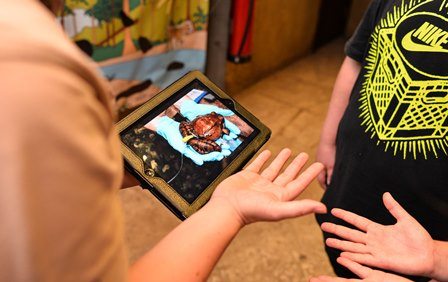It’s therefore important that we provide our visitors with opportunities to discover and learn about the biology and conservation of the species found here at Chester Zoo.
Wildlife Conservation is at the heart of everything we do. We use scientific evidence to help identify and address many of the challenges our natural world faces. We aim for our conservation research to help in decision making that improves the management of the animals and plants in our care-influence the sustainability of wild populations and inspire others to be motivated to join us in our challenge to Act for Wildlife.
Through visitor and community engagement we can tell people not only about the animals here at the zoo-but also their conservation status around the world and aim to inspire them to help make a difference – possibly inspire the next generation of conservation scientists!
That’s why we asked the question: “Are interactive activities for zoo visitors effective education tools?”
Due to the vast amount of variability among visitors-investigating the effectiveness of our educational initiatives can be difficult. One of the scientific studies carried out by a member of our discovery and learning team-evaluated the impact of informal learning practices and interactive activities in a zoo environment and identified variables that impact positively on the experience.
Two interactive activities at the zoo were evaluated. Both focussed on two species of critically endangered frog: the mountain chicken and the golden mantella.
Sarah Bazley-learning manager at Chester Zoo-carried out the research – here she tells us more about these amphibian themed activities:
“Although both activities are focussed around conservation efforts of critically endangered frog species-the species are not well known to the majority of visitors; their common names are unusual and don’t obviously describe them.
“There is a selection of field equipment and artefacts for visitors to explore and a member of the zoo ranger team is there to engage and discuss field conservation techniques employed to help each species.
“The mountain chicken activity revolves around the story of field researchers who monitor these frogs in the wild. These researchers microchip the frogs for identification purposes; health check the frogs by weighing and measuring the individuals found; and put transmitter belts on the frogs to track where they are and their survival rates.
“The activity at the zoo uses a number of toy frogs that have been microchipped and weighted. Visitors use the microchip scanner to firstly identify the frogs-then use Pesola scales to weigh and calipers to measure them. Our team also show photos on an iPad showing the researchers using the same equipment and same techniques in the field and there is a prototype of the transmitter belts used on the frogs for visitors to also look at. The zoo ranger is there to engage with visitors and guide the activity around this story.

“The golden mantella activity revolves around the story of field researchers who are monitoring the populations of these frogs in the wild. As you may have seen on a previous blog-our conservationists are able to monitor golden mantella populations in Madagascar using an innovative technique of using a silicone implant that glows under UV light.
“The activity we run in the zoo involves a number of toy frogs marked with UV ink-so not obvious to the naked eye-and visitors use a UV torch to identify the marked individuals. A number of transparent toy frogs have been injected with the silicone and the equipment used is there for visitors to look at. Visitors can have their hand stamped with UV ink-and use the torch to reveal a frog outline on their own hand. Photographs on an iPad show the researchers using the same equipment and same techniques in the field-and the zoo ranger is there to engage with visitors and guide the activity around this story.”
Sarah interviewed a number of visitors using a series of open and closed questions designed to explore factors that may impact on informal learning in a zoo environment including; motivation for visit-prior knowledge-what the visitors found out during their visit and knowledge of amphibians and their conservation (in particular the amphibians focussed on in the activity) and awareness of Chester Zoo’s conservation work.
Individuals were interviewed on days the activities weren’t available to act as a control. We found that visitors that engaged with interactive learning activities achieved stronger learning outcomes regarding their knowledge of endangered animals-but little impact was observed regarding knowledge of Chester Zoo’s conservation efforts.
It is possible that this was due to the high awareness already established in most of the visitors. Moreover-those that had visited the zoo with motivations to ‘see the animals’ appeared to gain more from the interactive activities than visitors with alternative motives.
Following the results of this study-recommendations were made to continue using learning and interactive elements to informal learning delivery at the zoo but as there appears to be a particular group of visitors that benefit from interactive learning-activities designed to target specific audiences would be ideal.